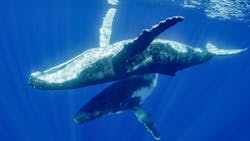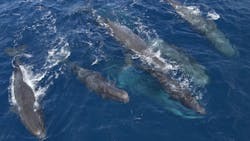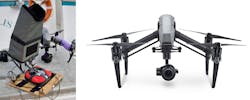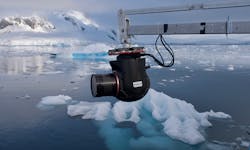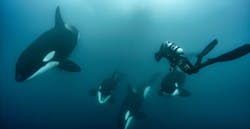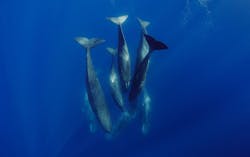Thar Be Whales—What’s Their Secret?
The Secrets of the Whales is a four-part, National Geographic/Disney+ series about…whales (Fig. 1). It’s produced by James Cameron and photographer Brian Skerry with narration by Sigourney Weaver. It was filmed in 24 locations over a period of three years and the results are impressive, as it exposes the cultures of the orca, beluga, narwhal, sperm, and humpback whales.
Now that we have that out of the way, we can concentrate on the filming technology that Brian Skerry and company employed to get some fantastic shots of the whales. I was able to talk with Brian about the series and how it was filmed.
Essentially, the crew did three types of shoots, including feet in the water, on the boats, and in the air. The latter provides images from above (Fig. 2).
For airborne filming, the photographers employed a helicopter or one of many DGI Inspire 2 and DGI Phantom drones (Fig. 3). Each had its advantages and disadvantages. The helicopter was larger and more expensive, but able to carry a heavier payload than the drones for a longer period of time. Cameras used from the helicopter could utilize larger and heavier zoom and wide-angle lenses, providing more photographic options without changing lenses.
The drones were significantly smaller; having multiple drones meant that different configurations could be set up ahead of time. Likewise, the limited flight time, about half an hour, required swapping drones. Multiple drones weren’t used because past issues with controller/drone conflicts were cause for concern. Newer drones have fewer issues in this sense, but usually one drone in the air was sufficient.
Some of the challenges using the drones included more limited lens options as well as the requirement to swap lenses to change capabilities, which otherwise could be combined in larger lenses used in the helicopter or from the boat. A typical configuration had a fixed, 50-mm lens. A pair of drones were typically used, allowing for battery or lens swaps. Landing also was a bit problematic, due to the metal from the boards causing GPS issues. Manual landing was the usual alternative.
I did ask about challenges regarding the drones, and wind was obviously a factor. Turns out the DJI drones did pretty well even in the Falkland Islands with 40-knot winds, although the drones were almost tilted sideways. Overall, they did very well as the results attest.
I also asked about noise, but given the critters were in the water, it didn’t seem to be much of a problem. Underwater sounds like low-frequency sonar are more of an issue.
Filming from the boats often employed a gyro-stabilized-system (GSS) mounted camera attached to a jib arm (Fig. 4). This allowed stable shots above the waterline from a moving craft using a super-telephoto lens.
A special pole arm rig was also used to take some underwater shots (Fig. 5). The pole arm was normally deployed from a stationary boat since it was handheld.
Freediving techniques were employed to capture most of the underwater moments, which involved the use of a low-light sensitive RED Gemini camera (Fig. 6). Filming the photographer could be done by another diver or using the pole arm camera.
I enjoyed watching the series and learned quite a bit. I wasn’t aware of the family-oriented pods or the range of communication methods. We normally see whales shown at the waterline, but so much is done underwater, such as diving for giant squid or simply sleeping, which are revealed by the series (Fig. 7).
Stories like Moby Dick and movies like Star Trek IV: The Voyage Home (Fig. 8) simply don’t get whales quite right. Whales requires closer study, and the observations reveal a much more interesting and nuanced understanding of the plethora of whales that are challenged by the way we humans take care of our water and its inhabitants. I was fascinated by the variety and complexity of communication methods employed by the different species and even groups with the same species.
Most of the technology mentioned here doesn’t show up in the videos because it’s usually involved in doing the filming. However, it’s apparent how different the coverage is compared to prior movies that didn’t have these advantages.
You can also check out the book Secrets of the Whales by Brian Skerry. That’s what I’m working on now.
About the Author
William G. Wong
Senior Content Director - Electronic Design and Microwaves & RF
I am Editor of Electronic Design focusing on embedded, software, and systems. As Senior Content Director, I also manage Microwaves & RF and I work with a great team of editors to provide engineers, programmers, developers and technical managers with interesting and useful articles and videos on a regular basis. Check out our free newsletters to see the latest content.
You can send press releases for new products for possible coverage on the website. I am also interested in receiving contributed articles for publishing on our website. Use our template and send to me along with a signed release form.
Check out my blog, AltEmbedded on Electronic Design, as well as his latest articles on this site that are listed below.
You can visit my social media via these links:
- AltEmbedded on Electronic Design
- Bill Wong on Facebook
- @AltEmbedded on Twitter
- Bill Wong on LinkedIn
I earned a Bachelor of Electrical Engineering at the Georgia Institute of Technology and a Masters in Computer Science from Rutgers University. I still do a bit of programming using everything from C and C++ to Rust and Ada/SPARK. I do a bit of PHP programming for Drupal websites. I have posted a few Drupal modules.
I still get a hand on software and electronic hardware. Some of this can be found on our Kit Close-Up video series. You can also see me on many of our TechXchange Talk videos. I am interested in a range of projects from robotics to artificial intelligence.
